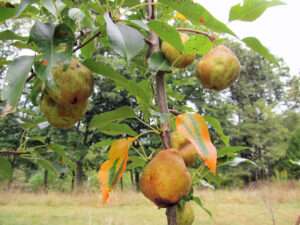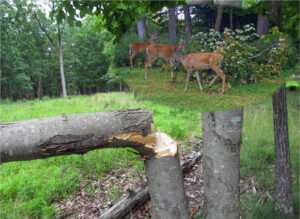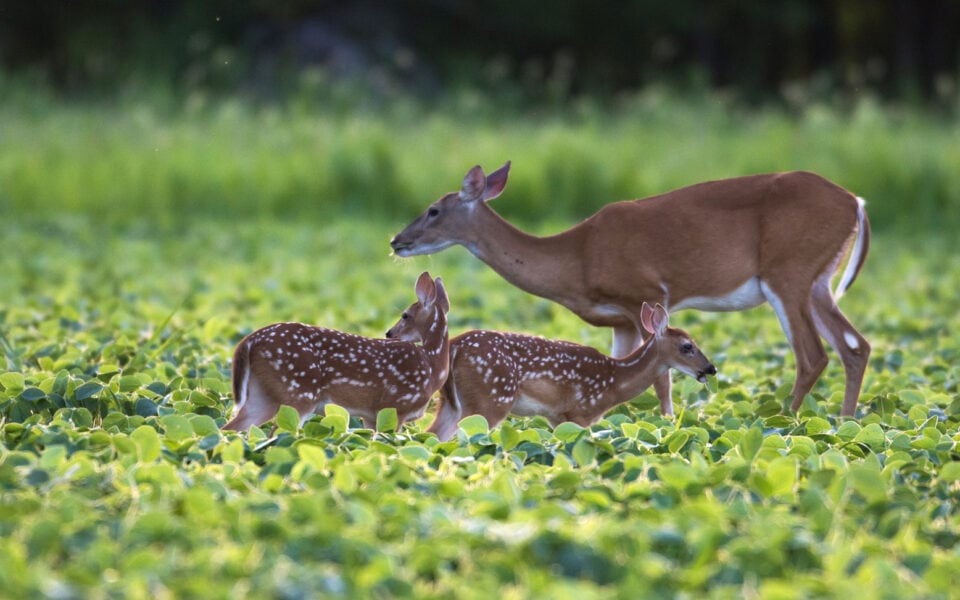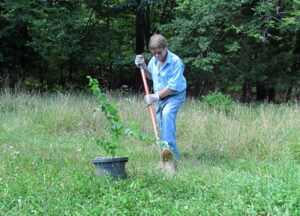PHOTO BY: Tony Campbell
Many hunters and novice land managers assume that summer is a time of limitless, green, high-quality forage for deer – the ultimate season for whitetails. There are lush green foods high in nutrition everywhere they turn. Unfortunately, it’s not quite that clear-cut and positive of a picture. In fact, in most regions, spring and fall offer superior fare for deer. About the only thing you can say about summer is that it’s usually better than winter. However, even that’s not always the case, depending on the property’s management plan for fight summer nutrition challenges for whitetails. A setup with abundant brassicas, cereal grains, and native browse could actually offer better winter forage than summer in some cases.
Soaring temperatures, extended droughts, the sun’s angle to our hemisphere causing long hours of sunlight, and drying winds all take a toll on vegetation during summer – both native species and your food plots. The natural cycle of many plants sees them emerge with a flush of tender-leafed growth, high in protein initially in spring, then fade back to a less palatable, less nutritious state. The moisture content of the vegetation that was high from spring rains also declines.
This is not to say that mature, fully leaved plants are not valuable during July, August, and early September. They definitely are. It’s just that they don’t match the high protein levels, nutritional value, and tenderness of spring’s first growth. Mother Nature really doesn’t supply the quality of nutritious forage necessary for white tails to achieve their full potential.
When you add the challenge of drought, which many regions of the country have been plagued with in recent years, plus long daytime hours of relentless sunlight that can stress plants, it becomes clear that summer is definitely not the “horn of plenty” that many beginning land managers assume it is. Just because it’s green doesn’t mean its good whitetail fodder.
But like all challenges gamekeepers face in managing the land for wildlife, there are solutions. Here are 11 steps I’ve taken on my property in Virginia to try and “fight back” against the difficult conditions of summer and keep nutrition levels high in both native forages and my food plots. Not all of these will be appropriate for every property, but several of them should be useful projects for improving the quantity, nutritional value, and palatability of forage during hot weather just about anywhere white-tails are found.
1) Plant early-maturing fruit trees 
The first big, old doe with the “Roman nose” starts checking the apple tree just outside our living room window as early as June. That old girl wants to be first and she knows this particular tree, which was here when we bought the property 25 years ago, is the earliest to bear fruit. With the prolonged droughts we’ve experienced it’s no wonder she tries to be at the front of the line for this sweet, high-moisture content food.
Fruits such as this are full of Vitamin C and vital minerals such as potassium and phosphorous. They provide a strong sugar and carbohydrate energy boost as she feeds her newborn fawns. They also offer variety from the usual summer fare, something vital for getting animals to stay on your property during this trying time of year.
Photo By Gerald Almy
Besides the fruit trees already here, I also plant early-maturing varieties such as Centennial, Liberty, Rome, Horse, and Enterprise, in addition to pears that can ripen in July and August such as Carnes, Jubilee, Summer Crisp, Sunrise, and Harvest Queen. Other early fruits that can attract and help deer during summer’s stress include plums, crabapple, mulberries, and peaches.
There’s nothing wrong with planting late-ripening apples, pears, and persimmons for a hunting site, but planting some of these early-bearing fruit trees significantly adds to the property’s food diversity as well as being a great gift to your animals. One study showed that an acre of pears can yield up to ten tons of fruit! Plant fruit trees on gentle slopes if possible, spacing them about 20-30 feet apart.
If you’re lucky enough to live on the property so you get to watch them feed, like I am, that only adds to the benefits. Rest assured, even if you’re an absentee landowner, early fruits will not only help your herd, they also make it a special place that helps hold the animals on your land.
2) Fertilize plots, but only at appropriate times
Adding fertilizer when it’s dry, hot, and the plants are stressed is a waste of time and money and could even be harmful to a food plot. But if your clover or clover-chicory plants seem to be slacking off in production, a shot of phosphate and potash such as 0-46-0 and 0-0-60 at the appropriate time can give them a great summer boost. Only do so if the plants are growing and there’s adequate moisture, both in the ground and in the forecast. Then try to add it immediately after a cutting.
There may be some summers when you don’t encounter these appropriate conditions. If so, hold off. But when you do have the opportunity, a shot of mid-summer fertilizer can give a perennial plant a nice boost in growth, palatability, and nutrient levels. You also may want to consider an application of Deertrac at that time to boost taste appeal and micronutrient levels.
3) Keep the moisture in the ground. 
If you need to prepare some plots for summer bean and pea plantings or later for brassicas and cereal grains, do so with the least soil disturbance possible to leave as much moisture in the ground as you can.
Gamekeeper’s Editor in Chief, Todd Amenrud, has laid out a “switched around” way to prepare plots from the standard method of spraying for weeds, then waiting, then tilling and planting. He recommends tilling several weeks in advance of planting, then spraying after new grass and weeds have germinated – then plant without working the soil again. Reduced soil disturbance with this method means less water loss. The more tilled ground you re-expose repeatedly to surface air and sunlight the worse the moisture conditions get for successfully growing your crop.
Alternatives are no-till planting and planting into crop residue. These techniques, where practical, are even better still for preserving moisture. Photo by Gerald Almy
4) Mow perennials–but ONLY at appropriate times.
It’s hard to say exactly when a perennial plot of clover should be cut. Generally it’s when weeds become a problem and grow a few inches taller than the forage, or when a significant number of the plants start to flower. Cutting reinvigorates the plant, stimulates increased stolen growth, and yields fresh, succulent leaves that are especially attractive to deer and other wildlife.
These young plants also have a higher nutritional content, so cutting is a great step to improve your summer forage quality as well as quantity. I cut some clover plots 4 or 5 times a year, others just a couple. It depends on the weed growth, amount of flowering and how well deer are keeping it eaten down.
Timing is crucial with mowing. Never cut when the conditions are brutally hot and dry and no rain is in the forecast or when the clover looks stressed and “tired.” Those two situations usually occur together because of the toll that heat and drought extract from the plants.
One of the many ways to combat the summer nutrition challenges for whitetails is to simply offer deer more forage, and at the same time, more variety of forage. Shrubs offer a great way to do this. A few good choices include silky or red osier dogwood, Allegheny chinquapin, raspberry, Chickasaw plum, strawberry bush, and American beautyberry.
Plant them along woods borders and edges of fields to create a feathering effect. That will make animals feel comfortable coming out earlier so they can get more feeding in at major plots and crop fields. You may have to protect the shrubs with tubes and water them early on after planting if rain is lacking.
Photo By Gerald Almy
6) Plant crops that require minimal moisture
This one is somewhat commonsensical and most gamekeepers are familiar with, but it’s so vital it bears repeating. Unless you live in an area with abundant rain-fall, expect the worst and plan ahead by planting crops that thrive with only small amounts of precipitation. The major choices to consider include lablab, forage soy-beans, alfalfa, and chicory. By planting several of these you’ll have forages available to deer even during the driest July and August conditions.
Alfalfa and chicory can be planted alone or mixed with clover to take up the slack and keep a plot producing when dry, stressful conditions prevail. Soybeans grow deep roots and can be planted by themselves, mixed with peas like Biologic’s Spring Protein Peas, or combined with nurse crops such as sunflowers, sunn hemp or sorghum, which will protect the young plants to a degree and also provide a base for the beans to climb.
7) Plant a few small plots in the woods early
These plots are not the normal secluded kill plots back in timber that you plant during July through September for a hot bow hunting site. Rather, they are plots sown in similar areas during late spring with a slightly different crop, including plants such as buckwheat and clovers to provide succulent hot-weather forage. They’re for deer health and attraction, but not hunting. The woods keep these mini-plots shaded so they have enough moisture to offer green forage even in summer’s heat.
Chances are they’ll be hammered to nothing by late August, but serve their purpose – one more small way to fight back against the nutritional challenges of summer. The good thing is that once more consistent rain is on the horizon, say during late July through September, you can replant these decimated sites with brassicas, cereals and annual clovers or a mixture such as Hot Spot or Last Bite and still have a great ambush site for an October buck.
8) Plant a few small plots in the woods early
Too many people look at these crops as “autumn” plantings. It’s true, you can put them in as late as October or November in the far south and get good late fall through spring forage, but consider sowing at least some of these crops at the earliest time recommended or even slightly before that.
In northwestern Virginia, where mid-July is the earliest recommended time for most brassicas, I’ve put them in as soon as June. That yielded some great crops coming up in July and providing lots of forage right into August. If the deer ultimately decimate these early plots or they go to flower, so be it. They will have served their purpose. I’ll put other ones in later at more traditional times that will thrive into fall and winter.
I’ve pushed the envelope similarly with cereal grains with July winter wheat plantings. In years with good moisture these early wheat crops tend to get mostly ignored because there’s so much other food available (clover, beans, etc.). However, in drought years when some of these other crops are struggling or I didn’t put in enough, deer will flood into these early grain plantings before most people have even thought about putting them in the ground.
9) Hinge-cut some low-value trees 
This is normally considered a winter project, but if conditions are extremely stressed, this project can help during summer as well. I found this out by accident while I was pruning some trees near my house that both blocked the view and got in the way of satellite dish reception. That evening several does and fawns found the pin oak branches I’d trimmed but hadn’t yet moved, and they enjoyed dining on the green leaves and twig tips.
Later I took this information a step further and instead of pruning, I actually cut or hinge-cut a number of low-value trees, putting the food down at deer-feeding level. It’s a great way to provide quick nutrition to stressed animals and open the forest canopy to more sunlight.
10) Plant plots that benefit from late-afternoon shade Photos by Almy, Medvecky
Summer plots in most cases get plenty of sun. Sometimes too much if it’s brutally hot and dry. Position some of your clover plots so they have canopy trees bordering them on the south, west or southwestern edges. The shade from the trees will provide relief from the scorching sun during the hottest period of the day. That means less moisture depletion and less stress on the plants.
11) Consider installing or renting a sprinkler system 
You probably can’t water all your plots, but if you can set up a sprinkler system that will allow you to provide moisture to a few of them, that will give deer a few lush, moisture-filled feeding sites. And that, in turn, will take some of the pressure off other stressed plots that you can’t irrigate.
I use a spare well on my property to water a number of plots every summer, stringing together adapters and hoses to cover plots up to 600 feet away.
Another great option are the systems that include sprinklers, hoses and pumps offered by Big Sprinkler to pump water from ponds, streams or windmills. They have setups starting for less than $1,000.
You can also rent pump-and-hose systems for a short-term solution, but chances are you’ll spend enough in a few summers of renting that you’ll wish you’d bought the equipment instead.





0 Comments